You have no items in your cart. Want to get some nice things?
Go shopping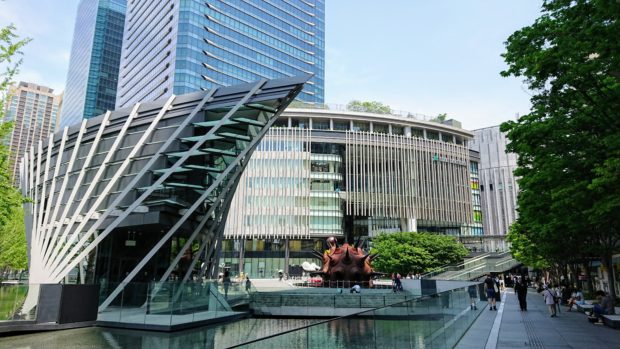
Start from part one of this series.
“Do you think they’re Yakuza?” My husband’s eyes slid over to a group of men sitting at the table next to us. They wore long-sleeved shirts and laughed as they smoked. Something about their general demeanour ruled out “salarymen”.
We were in a small, homely restaurant consisting of one chef and one waitress; a throaty young woman whose kindness was a surprising balance to her volume and no-nonsense delivery. In my bare Japanese and her curtailed English we managed to ensure a ramen for my husband, and for my vegetarian self a donburi (rice bowl with vegetables) topped with a fried egg. We’d heard a lot about the rich food culture in Osaka, and were excited to indulge. Shame, then, that I couldn’t eat anything from the dozens of menus we’d looked at so far. Once again I was dragging my husband down – but in my defence I insisted he eat wherever he wanted while I grabbed sushi-on-the-go from a 7-Eleven. He, however, insisted he wouldn’t eat alone while I simply watched, starving like an urchin at the window. I don’t like being awkward, so I sulked. As one of the few establishments in Osaka that may possibly have offered a vegetarian option, this restaurant had taken us longer to locate than expected, seeing as Google Maps wasn’t too clear about the difference between above ground and below ground.
Now there was the possibility we’d found ourselves near a very different kind of underground. If there’s one thing I know about the world, it’s that organised criminal activity could be going on anywhere at any time. And it wasn’t beyond the realms of possibility that four members of the Yakuza, one of the most notorious crime syndicates in the world, might be taking a lunch break next to a couple of tourists in Osaka. After all, in Kyoto we’d seen a geisha. Anything could happen.
“Well, they are covered up,” I said, having flicked a glance at the men while helping myself to soy sauce. “And it isn’t cold.”
Yakuza are easily identifiable in Japan as being some of the few Japanese (outside of the trendier youth) who sport tattoos. Inked bodies are generally refused entry into onsen, which is the polite Japanese way of saying “No Yakuza” – after all, gang members can only really be sure a troublesome “associate” isn’t carrying a gun if both men are completely nude in a steamy bathhouse.
The shirtsleeves might have been concealing tattoo sleeves, or they may only have been keeping up a state of decency. Either way, we tried not to look at the men with slick hair, joking and ribbing each other next to us like a group of guys in a Tarantino film.
*
More likely to get us killed in Osaka were the cyclists. Two-wheeled citizens are commonplace in Japan, and after a few days the sight of a young mother with a toddler strapped to one end of her bike plus a dog or second child on the other end of it barely registers. Rather than a useful safety measure, bicycle bells are considered an impolite affront, while whizzing over pavements regardless of the number of pedestrians is totally acceptable. On foot you just take your chances, trusting that an Asian Bradley Wiggins weaving around you at top speed won’t put your lights out.
The roads were wide, and full of traffic. Above those soared a flyover. Beneath a bend in that was a canal. As in Tokyo, there was so much that was screaming to be noticed: glass buildings, taller than any in England, the lights and noises of adverts. For whatever reason we were drawn into a side street of parked bicycles and posters for unknowable ads, perhaps because we latched onto the familiar sight of Family Mart (our saviour equivalent to 7-Eleven), whose blue and green illuminated sign shone out like a beacon amid the frenzy. We turned a corner and came upon a pachinko parlour. This time, we decided to go in. How could we bypass the opportunity to experience a slice of modern Japanese culture?
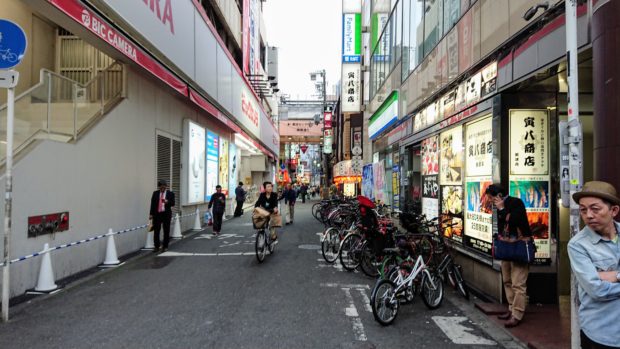
Pachinko is something of a controversial character. Introduced by Korean immigrants, the game is a cross between pinball and fruit machine, and is more than likely rigged in the house’s favour. Nevertheless, it has made addicts of many locals, some of whom are found queuing outside early in the morning, waiting for the parlour doors to open. What with the troubled history – and, even to this day, fraught relations – between Japan and Korea, it’s curious that this pastime took such a hold here. Many Korean migrants claim to be treated as second-class citizens in Japan; even Koreans born here are regarded as temporary residents, without Japanese nationality (though a few thousand of them do become nationals every year). Pachinko parlours seemed to me to be, in some small way, Korea’s revenge.
We were unprepared for what greeted us inside. If the gaudy bright colours, neon lights from the shiny metal machines and unending bunting weren’t loud enough, the din of the game itself was beyond anything we’d ever endured. We did a quick turn of the place, passing middle-aged men and elderly ladies calmly loading their yen, our heads beating at every bleep and ring and clash of falling coins, and headed for the exit. Signs told us not to take photos. We passed an employee, a young usherette holding a box of snacks. She stood perfectly still with buds in her ears. She stared ahead of her, vacant, as if the barrage of sensations had rendered her senseless.
*
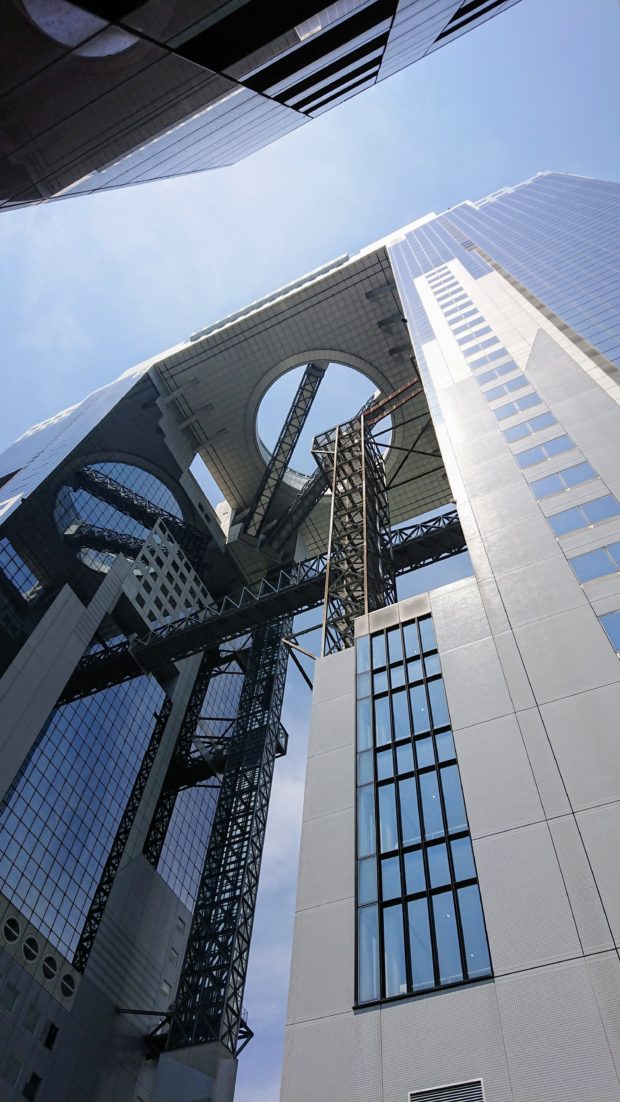
More our idea of entertainment was Umeda Sky Building’s 39th-floor Floating Garden Observatory. Only a stone’s throw away from the modern complex surrounding the central station, the district feels miles away from the industrialised port town I’d envisaged in my school-day history lessons. Osaka residents were once stereotypically portrayed as greedy, lascivious and stingy. But here were grey-suited businessfolk powerwalking to a meeting or chilling by a meditative water feature. We went beneath colourful streams of coy-carp windsocks into the entrance of a grand skyscraper. Made of two glass towers joined by the Sky Garden at the top, the Umeda building cuts an impressive figure in Osaka’s skyline. The lift ride alone would make a heart soar, but the views of the city from the top were something else. From here we could see the fingers of land reaching out to the sea, where long-ago wooden ships would have docked or departed. We spotted bridges that called like sirens to my bridge-enthusiast husband. That’s when I knew that our rare couple-selfie moment was a mere prelude to a long trek towards them.
As we wound our way through Osaka’s blander neighbourhoods to reach one of those bridges, my resentment of my husband for making an old man walk so far began to dissipate. My jeans were distractingly loose. I must have lost inches of body since we embarked on our honeymoon. I thought back to our hike through the Kiso Valley, our unending explorations of Kyoto and Tokyo, our bike ride in Miami prior to all that. But counterbalancing my elation at a reduced waistline was my fear of malnutrition. I had joked before coming to seafood-crazy Japan that as a vegetarian, I’d probably be eating nothing but rice for a month. I’m Mediterranean. We eat for hours. Wasting away is the stuff of our mothers’ nightmares, even when they call us fat and greedy. But the truth is I’d been eating well. Though it was sometimes a challenge, I’d managed to source or negotiate so much delicious food here.
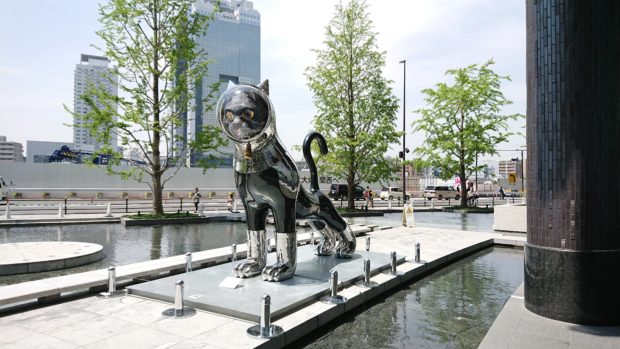
I decided I would feel smug and buy a belt. Luckily, my husband had taken his quota of bridge photos for the day and we were already on our way to Dōtonbori. Once the theatre district of Osaka, the area is now a major nightlife entertainment spot and tourist trap. It runs along a canal, above which one of Japan’s most unusual and charming landmarks hangs: Glico Man. Depicting an athlete on a track, the advert for Glico Candy has been in that very spot since 1935. This is its sixth incarnation, in glorious LED in place of the previous five’s neon. It’s customary for visitors to strike Glico Man’s victorious pose in front of the ad, so my husband dutifully waited for other tourists to do so before doing so.
I wandered into a clothes shop in search of a belt. While I was at it, I picked up shirts and T-shirts and tank tops I wouldn’t normally go for, figuring that I may as well transform into a totally new being. Wasn’t this what travelling was all about? Didn’t Elizabeth Gilbert go through this very thing? My ambition was snipped, however, when I got to the changing rooms. The sales assistant, pretty, polite, gave me a piece of gauzy material and gestured for me to cover my head with it. I nodded that I understood. I wasn’t supposed to dirty the goods with my potential hair-grease or lice until I had purchased them. That didn’t help me feel any less baffled when, having got into a cubicle, I put on the head bag and could barely see out of it. I wore one of the t-shirts I’d picked up, but all I could make out in the mirror was a pale figure who looked in line for a hanging. This wasn’t going to work. I put on my old self’s clothes and went to pay for the belt.
With my trousers secured, I could now freely wander off in search of dinner. One of the multitudes of methods I employed to track down veggie-friendly meals suggested an establishment whose cuisine was so out of the ordinary we knew we had to try it: Japanese-Jamaican fusion. We tramped to a district that felt the spiritual cousin of London’s Soho. A network of streets and alleys lit mostly by the signs of bars and clubs. Having made our way to a quieter part of the maze, we retraced our steps again and again, consulting the map, cursing the map, cursing directions and ourselves, only to conclude that this promising Asian-Caribbean restaurant was either a gastronomic El Dorado, or merely a pop-up street vendor whose schedule we couldn’t discover.
Disheartened, we grabbed a bite at a snack bar where the waitress looked at me so apologetically for not being able to offer much to suit me that I almost told her to wheel out a hog roast. My meat-eating spouse, on the other hand, would go on to have a second dinner. We ambled back to Dōtonbori, where the crowds had doubled. Food stalls had been set up along the street, where arcades and shops selling souvenirs and tat were still buzzing. We wandered into one, allowing our senses to be battered as if we were back in the pachinko parlour. But the tourist shop turned up a curious sight: a mascot by the name of Kuidaore Taro. Originally attached to a restaurant, the red-lipped drummer with a candy-striped conical hat has now established himself as an unofficial representative of Osaka. His smiling face can be found on sweet packets, biscuit tins and purses. Of course I only found out details later with some Google research, but I’d already got the gist. It’s surreal to immediately connect with a society you know little about; merchandise as shorthand for interpreting a culture. Surreal but pleasing.
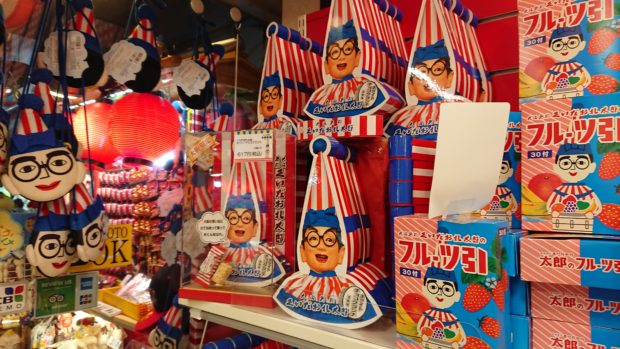
We left to stroll along the canal. In this part of town, buildings were spectacles. Dragons burst from the walls of shops, Spiderman scaled them, eighteenth-century dandies rotated on swings from them. It was only a matter of time before we came across a brightly-lit octopus cooking himself into a snack. We’d stumbled on takoyaki, one of Osaka’s best-known foods; balls of fried batter stuffed with octopus. Possibly because he’d already eaten dinner, my husband couldn’t eat more than a couple of these. That didn’t stop him from having dessert.
We sat by the canal, watching the rainbow of neon and LED lights on the water. We held a bag of local sweets between us, bite-size sponges containing either a vanilla or matcha custard inside. I’m still scouring the Internet to find out what they’re called but, as with Osaka itself, I wanted to like them more than I actually did.
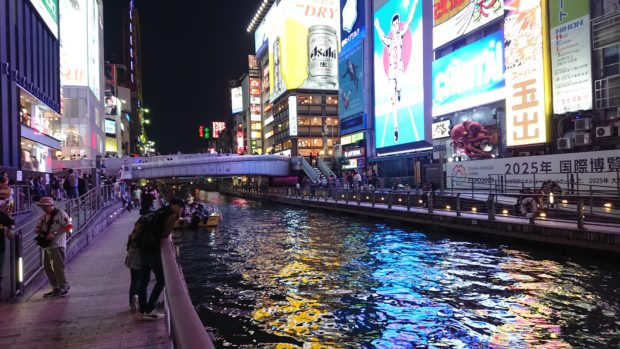
*
That night, we settled into our beds at the hostel. Little did we know then that the room would be so hot we would get no sleep. We were to be up early for a bus journey to our next stop. For the time being, we happily chatted with two backpacking Australians. I’d taken out my lenses, so they probably thought I was looking at them funny. But my raised eyebrows would’ve been a clear enough signal of my feelings when the Ozzies mentioned they’d been in Osaka for five whole days, after spending only two in Kyoto. A single day in Osaka had sufficed for me. I was ready to sleep and leave, which was the opposite of what I’d experienced in Kyoto. Even now in retrospect, I can’t put my finger on why I felt this way but my husband agreed. I’d felt the vibrancy of the shopping and entertainment districts; I’d appreciated the dedication to contemporary art and architecture, the ubiquitous Japanese element of water features in public spaces; and I’d especially enjoyed that view of the city from the sky garden. But I was ready to move on. Osaka, with all its lights, for all it had to offer, made me feel like the Glico Man. Bright, smiling, but running on the spot.
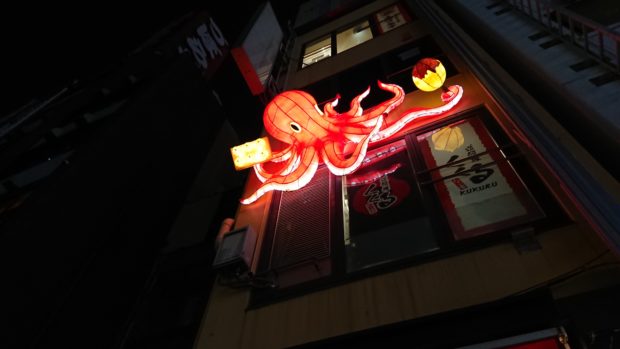
To be continued.
Polis Loizou’s debut novel, Disbanded Kingdom, is out now.

About Polis Loizou
Polis Loizou is a co-founder of The Off-Off-Off-Broadway Company, which primarily performs his plays, and has had a series of successes since their first hit at the Buxton Fringe in 2009. His short stories have been featured in The Stockholm Review of Literature and Liars’ League NYC, and he is a frequent contributor to Litro Magazine. Born and raised in Cyprus, Polis is currently based in Nottingham after 14 years in London. 'Disbanded Kingdom' is his first published novel. He is currently represented by Litro's bespoke literary agency, Litro Represents.
- Web |
- More Posts(25)




